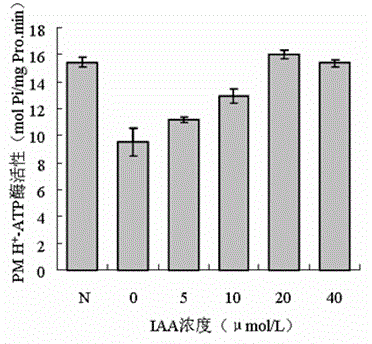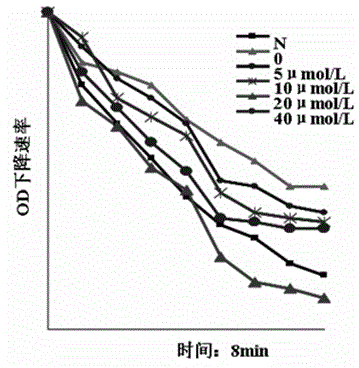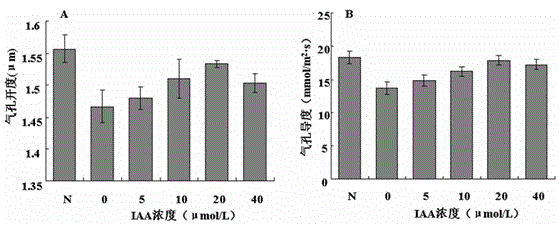Application of auxin on aspect of improvement of air formaldehyde pollution purification by potted plant
A plant purification and auxin technology, which is applied in the field of plant purification of air pollution, can solve the problems that affect the absorption and purification of formaldehyde by plants, low purification efficiency, cumbersome operation, etc., so as to improve the ability of plants to purify air formaldehyde pollution and increase the opening of stomata and conductance, the effect of simple operation
- Summary
- Abstract
- Description
- Claims
- Application Information
AI Technical Summary
Problems solved by technology
Method used
Image
Examples
Embodiment 1
[0020] Embodiment 1: the cultivation and processing of broad bean plant
[0021] 1. The experimental material is broad bean seedlings. After the broad bean seeds are germinated, they are sown in flowerpots mixed with red soil and perlite at a mass ratio of 6:1. Three germinated robust seeds are placed in each flowerpot, watered once every two days during the cultivation period, and water is applied after the leaves grow. One Hoagland's culture solution, used for this experiment when the seedlings grow to four pairs of leaves;
[0022] 2. Configure IAA treatment solutions with different concentrations (5, 10, 20, 40 μmol / L);
[0023] 3. Spray the lower epidermis of broad bean leaves with the above-mentioned concentration gradient treatment solution respectively. The lower epidermis is covered with water drops without dripping. After treating the IAA treatment solution for 8 hours, put the broad bean plants into the air containing 14.8 mg / m 3 In the glass airtight chamber...
Embodiment 2
[0025] Embodiment 2: adopt the broad bean leaf after the 3rd step processing in embodiment 1 to carry out PM H + -ATPase and H + - Pump activity assay
[0026] 1. Plasma membrane protein extraction and concentration determination: The plasma membrane of broad bean leaves sprayed with different IAA concentrations was extracted using a kit from Beibo Reagent Co., Ltd. The plasma membrane protein concentration after extraction was measured by Bradford method, in 800 μL ddH 2 Add 5 μL of plasma membrane protein to O, mix well, then add 200 μL of Bradford solution, let it stand at room temperature for 10 minutes, detect the protein concentration at OD595 wavelength, and calculate the volume corresponding to 50 μg of plasma membrane protein.
[0027] 2. PM H + -ATPase activity assay steps are as follows:
[0028] (1) PM H + - The determination of ATPase activity was carried out in a 0.5 mL reaction system; the reaction system contained 50 mmol / L BTP / MES, 5 mmol / L MgSO 4 , 50 ...
Embodiment 3
[0035] Embodiment 3: Determination of leaf stomata opening and conductance
[0036] Get the blade that has been processed for 1 hour in the third step of Example 1, tear off the epidermis, place it on a cover glass, add a drop of physiological saline, cover the cover glass, observe and measure the stomatal opening under a medium-magnification microscope, 40 random measurements were taken for each concentration, and the average value ( image 3 A). The stomatal conductance was measured with a yaxin-1301 plant porometer (Beijing Yaxin Liyi Technology Co., Ltd.), and each treatment concentration was measured three times, and the average value ( image 3 B).
[0037] From image 3 A and image 3 In B, after spraying different concentrations of IAA, the stomatal opening and conductance of faba bean leaves were restored to varying degrees, but 20 μmol / L IAA had the largest recovery degree of stomatal opening and conductance of broad bean leaves.
PUM
 Login to View More
Login to View More Abstract
Description
Claims
Application Information
 Login to View More
Login to View More - R&D
- Intellectual Property
- Life Sciences
- Materials
- Tech Scout
- Unparalleled Data Quality
- Higher Quality Content
- 60% Fewer Hallucinations
Browse by: Latest US Patents, China's latest patents, Technical Efficacy Thesaurus, Application Domain, Technology Topic, Popular Technical Reports.
© 2025 PatSnap. All rights reserved.Legal|Privacy policy|Modern Slavery Act Transparency Statement|Sitemap|About US| Contact US: help@patsnap.com



